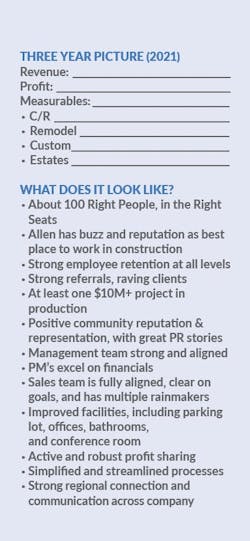Developing Traction
I am the CEO of Allen Construction based in Santa Barbara, Calif. We are an employee-owned business with about 100 team members and annual remodeling revenue around $30 million. One of our strengths at Allen is an ownership culture and sense that we’re all in this together. I love getting everyone aligned behind a goal or vision, and we work hard to raise people up to the point where they have full ownership over their area of the business.
A couple of years ago, we had a fairly new management team. We had restructured the company to six production managers in charge of different subdivisions, and we elevated a number of people to positions that were new to them. So the team was still getting to know each other, and we all needed clarity around roles, accountability, measures of success, and how we were going to do the measuring.
To that end, I got involved with Traction.
A New Framework
Over the years I’ve been in management, I’ve gotten involved with a number of executive groups, including Vistage and the Young Presidents’ Organization (YPO). I’ve found a lot of value in those groups. The idea is to meet with other business leaders in non-competitive fields who help me rethink my assumptions and give fresh perspectives on whatever challenges I’m facing. I first heard about Traction from a speaker in a Vistage meeting.
I don’t generally like new frameworks, and I was resistant in the beginning. But I spoke with a couple of other CEOs in town that were going through it and loved what it was doing for their companies. So, I ended up reading the book, Traction, by Gino Wickman, and totally got on board. I asked the entire management team to read it, and we jumped in with both feet.
Keeping a close eye on our measurables every week has helped align every member of the team, and made the business run more smoothly.
*Proprietary Information From Allen Construction
So, What Is Traction?
Simply put, Traction is a highly effective way of managing your company called the Entrepreneurial Operating System (EOS). It separates a business into six key components and creates a lens for looking at each of them. The components are Vision, People, Data, Issues, Process, and Traction.
It’s a strong, yet versatile system that’s become essential to the way we work. Traction has helped us set the right goals as well as decide who to hire, who to fire, and who to promote. It’s allowed us to paint a clear picture of what we want the company to look like in one year, three years, and 10 years. Having long-range targets that we all share has united us around common objectives. This helps when making decisions.
A Deeper Dive
Allen has a 35-year history in Santa Barbara, and we are known for providing concierge-level service. As employee-owners, we crafted a vision of who we are and incorporated that into Traction. Before Traction, we were holding monthly management meetings, but now we’ve changed them to weekly and it’s a fairly rigid format. There’s a formula to EOS discussions, and we stick to it.
During the first five minutes of the meeting, we each share two pieces of good news: one personal and one professional. It’s a great way to humanize the process and help with team-building. Next we go over our score cards. These are used across all six subdivisions and gives us a way of sounding warning alarms if there’s going to be an issue. If our operating cash or our sales are off track, that goes up on a white board. We have backlog targets around every division, and if it doesn’t hit the goal, that goes on the board as well.
We talk about this stuff every week. Nothing falls by the wayside. We also go over the progress on longer-term goals for each member of the leadership team, share important information, and report on action items left from the last meeting.
Outside Help
For the first three months, I tried to run the meetings myself, but everyone kept saying, “You need to get a consultant.” That was a little offensive to me since I actually used to be a consultant, but they were right. Bringing in another professional gave a stage to an outside person who had a ton of credibility. You often have to go over things a few times to get total buy-in, and having him helped with that.
Our Traction trainer meets with us quarterly. It started out more frequently than that, but now it’s on a rhythm. You don’t pay the trainer unless you feel that it was worth it, and we’ve benefited a great deal from his expertise. Our founder, Dennis Allen, is involved as well. It’s been powerful for him to see how we’re enacting his initial vision. Why are the core values so important? How does this process help us sell and go to market differently?
Traction is made for companies with anywhere between 10 and 250 employees. It’s flexible enough to conform to any company’s needs, but rigid enough to provide a scaffolding that works. It’s been a great learning experience for us all.


